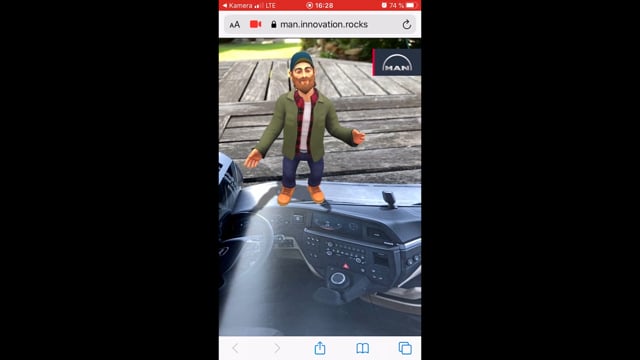Using Augmented Reality Avatars in Marketing
Here are three upgrades for optimized customer experiences and more consumer engagement.
Everybody’s Darling
We all know them and pretty much everyone has tried out their own digital alter ego. Avatars are now among the most widely used and popular applications in the virtual world. As software-based, virtual and maximally approachable ambassadors, we can design them completely according to our ideas and tastes. Above all, major brands such as Samsung or Apple have integrated avatars into their brand communication and made them an integral part of their customer experience management.
Today, avatars can even recognize and reproduce different moods. Thus, they always react adequately to their counterparts and prove to be unbeatable all-rounders in marketing, website design, apps and many other areas of application. They not only embody brand values and personalities, but can also be used for training and customer retention purposes.
The market is constantly being enriched with new, innovative customization options, and the tech and entertainment industries would be inconceivable without these small characters with their big personality.
![]()
Figure 1: Avatars for social media
Avatars: Technology or Religion?
As early as the 1980s and 1990s, users began creating digital personas in online games to represent themselves in virtual environments. These early avatars were simple graphical representations that could be used not only to explore virtual space, but also to interact with others. As technology advanced, however, the complexity and capabilities of avatars evolved. Graphics and animations became more visually appealing and more detailed. The avatars themselves became more lifelike.
Computer games such as World of Warcraft, The Sims or the Nintendo Mii characters have made the concept of the digital alter-ego popular in the 21st century as well. In fact, however, avatars have their origins somewhere else entirely: the basic idea can be traced back to ancient times. The “avatar” comes from Hinduism, where an avatar is described as the earthly incarnation of a god or goddess. Avatars, according to this religious understanding, served divine beings to descend into human realms and interact with the mortal world. High spirits instead of high-tech – but if the shoe fits…
![]()
Figure 2: Creating an avatar
Always One Step Ahead: Augmented Reality Avatars
Transferring the terminology to the tech realm is obvious: the setting merely shifts from the earthly world to digital space.
Augmented reality overlays the real, analog world with digital elements and thus overcomes the boundaries of virtual and physical spaces. This opens up entirely new, immersive possibilities for unforgettable customer experiences and thus stronger and sustainable digital customer engagement.
Avatars are thus integrated into the real environment of users with the help of AR – for example, as representatives of real people, but also as company mascots or virtual contact persons in digital customer service. They can take on any shape and body type, be equipped with voice-overs, individual gestures or multimedia content, and appear in real time on smartphones, tablets or using AR glasses. Unlike conventional avatars, AR avatars are not limited to a specific screen, but appear in the user’s real environment.
Long story short: AR avatars can appear in your living room, they are apt to conquer every comfort zone! And it is precisely this immediacy and versatility that makes them the perfect match in marketing and communications when it comes to customer centricity and the perfect customer experience.
Ambassador, Service Expert, Communications Professional
Avatars are true all-rounders. In the age of digital transformation, virtually all industries are constantly on the lookout for new and innovative ways to inspire customers and employees and effectively market products or services.
It’s Really That Simple (And Smart!)
1. Avatars as Brand Ambassadors
Whether influencer marketing, testimonial campaigns or mascots: maximum authenticity and, above all, emotional bonding have long since established themselves as supreme disciplines in the marketing sector. They promote a positive brand perception and create loyalty. An avatar is not only apt to embody the personality of a brand one hundred percent, but even become its face.
By interacting with the avatar, customers can get to know the brand in a playful way and actively experience it. This gives the brand an unmistakable face that the world can encounter not only on posters, but can actually become part of consumers’ everyday lives. After all, how well a brand stands out from the competition depends first and foremost on whether its uniqueness really sticks in people’s minds. The avatar is an active measure to increase customer satisfaction, the intelligent solution for a stronger brand presence and a real booster for overall competitiveness.
Meet Jay! ZEISS Diary webAR Presents The Best of Both Worlds:
Our joint project with Carl ZEISS is an exciting example of the successful use of a virtual brand ambassador: every year, the company publishes a calendar exclusively for employees and partners. This year, however, it was not to be a simple print product. With the intention of breathing more visionary spirit into their digital presence, we developed the ZEISS Diary webAR. As an efficient measure for customer loyalty and a forward-looking new pillar in the company’s CX strategy, our solution is convincing all along the line.
QR codes printed in the calendar can be scanned with the smartphone camera and guide the users into their very own AR adventure. The highlight of the web-based augmented reality experience is the animated 3D avatar of the real-life brand ambassador “Jay”. The virtual Jay not only resembles his analog role model on the outside, but even has his own voice!
Jay familiarizes users with the new app, provides interesting insights into the world of metrology, informs them about upcoming events, or pits them against each other in a quiz – all in three different languages so that all ZEISS employees around the globe can equally participate. Jay has thus become an important element in team building and employer branding. What’s more, he naturally accompanies all owners of the calendar day after day: interactive, informative and entertaining!
2. Support Avatars As Virtual Assistants
Avatars are all born with helper syndrome – but we can assure you: they love it! Avatars can be used in companies for training purposes, both in digital customer service and internally as virtual trainers. They answer simple and complex questions, provide targeted support for all kinds of challenges, and explain processes step by step.
Even product recommendations are part of their expertise, which also has a positive effect on customer satisfaction. Adios automated chat bots, hello individual avatar experience!
![]()
Figure 3: AR teacher
Customer Experience and Support via MAN tgx webAR
One example of ultrasmart customer service using an avatar is the MAN tgx webAR app. For the new MAN tgx truck, virtual customer support was needed to accurately and fully display and explain the details and features of the interior.
“Ben” had already been part of the vehicle manufacturer MAN’s marketing campaigns before. Now the fictional brand ambassador was also to play the leading role in an augmented reality experience that presents the new tgx 2020 truck in a breathtaking deep dive. The task was to develop a webAR app that is easily accessible for everyone and convinces potential buyers with its attractive features.
The avatar welcomes users to the digital experience and takes on the role of a virtual guide who vividly explains the details, special features and interior of the truck. Numerous functions and improvements to the driver’s cab can be explored individually in the browser. No one has to spend what feels like an eternity listening to bad elevator music on the customer hotline to ask questions – and if that doesn’t increase customer satisfaction!
3. Avatars as Promoters and Storytellers
Like protagonists in shows, movies or books, avatars are characters with their own story and specific background that can be created individually around the character. Not only are they part of telling a story around the brand and its communication strategy, they can also become storytellers themselves and thus add a creative, entertaining and maximally individual level to any brand universe.
Avatars offer a low-threshold and informal way to address customers. Gamification and interactive features motivate potential buyers to engage with the brand, participate in activities, and learn more about the brand. Whether as part of a marketing campaign to increase brand awareness or internally to help employees gain a deeper understanding of the brand, avatars tell any story in an immersive, informative and, most importantly, entertaining way.
A Journey Through Company History: Porsche’s Digital Brand Academy
The Digital Porsche Brand Academy, a joint project between Porsche and svarmony, shows what this can look like in practice. The first-to-market app is a virtual time travel through the company’s history that brings together all employees and fans of the brand around the globe – with the help of an avatar.
While the newly hired Porsche employees had no direct connection to the brand, the established ones wondered what the future of their company would look like. We created a digital brand training about company values, history and vision that is easily accessible and understandable for all employees.
Naturally, the avatar is dressed in the smart clothes of a Porsche employee, and his workplace is the body shop. He introduces the user to numerous animated Porsche models and leads them through three exciting chapters, from the company’s history to a powerful vision of the future. Together with him, users explore the world of Porsche, learn about the company’s values in a quiz, or get behind the virtual wheel of a brand-new Porsche.
The Digital Porsche Brand Academy is the innovative onboarding of tomorrow, the new entertaining way of brand training that has been well received by fans and employees of the brand worldwide and, quite incidentally, saves massive costs.
The Future Is Now
Whether they are brand ambassadors, digital customer support or storytellers, augmented reality avatars have the potential to transform marketing and communications by taking brand experiences to a whole new level across the entire customer journey, driving engagement and paving the way from brand awareness to true brand loyalty.
Through their interactivity, memorability, and ability to collect personalized data, avatars offer a unique opportunity for companies to stand out from the competition and commit customers for the long term. The future of marketing lies in connecting reality and virtuality – and avatars find themselves right at this interesting intersection.


